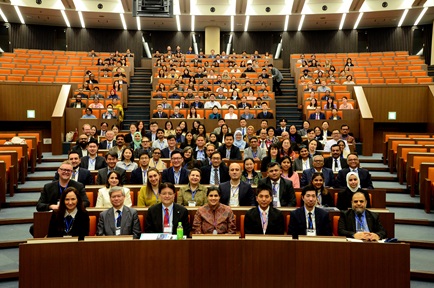Commodity trade should not profit from hunger
“A way must be found to break out of this spiralling food price rise or else the world could witness starvation on a scale not seen in living memory.
It is turning out to be a disaster of a year for global food security. More than 800 million people around the world are waking up hungry every day. Twenty million are on the verge of starvation in the Horn of Africa and 30 million depend on emergency food aid in the Sahel.
The cost of food has jumped, following the Russian invasion of Ukraine. Food prices are on the average 34 per cent higher than this time last year. The UN blames the confluence of climate change, pandemic and conflict for the crisis.
Making the bad problem worse is the commodities market. Investors who have nothing to do with the production or distribution of food grains, cereals or pulses are making speculative bets on the futures market driven only by a desire to make profits.
Investment funds have increased their stakes in agricultural commodities in the last two years, according to an investigation by a multi-national team of reporters and published by Lighthouse Reports, a non-profit based in the Netherlands. In the global Paris milling wheat market, their share of wheat futures has increased three-fold since 2018.
Hedge funds now dominate the trade in staples. This is worrisome. Food is essential for survival. It should be traded as an essential public good not as an asset. But then we do not live in an ideal world. Investors today are clamouring over few reasonably priced inflation hedges left on the market. In the current environment - when capital is bolting for safety - agriculture commodities have become exceptionally attractive.
The global food commodities market today is worth US$6.4 trillion (S$8.9 trillion) and Singapore, home to some of the biggest names in agribusiness and commodity trading, is a major hub. As the wheat futures price rose to an all-time high in March, investors bought agriculture commodity linked ETFs like never before.
The Teucrium Wheat Fund, for instance, saw such a dramatic inflow of capital that month that the New York Stock Exchange ran out of shares to sell. It is by no means the only agriculture-based fund to see positive action. Other agriculture commodities-linked financial products have also seen a rally this year.
As prices of wheat, sugar, and cereals climb, some are indeed engaging in trading activity that can only be described as profiteering. That includes locking in supply contracts, hoarding, and excessive speculation.
In February, Pakistan launched an official investigation on traders accused of making "undue" profit margins on onions, tomatoes, and potatoes. India imposed a ban on wheat exports on May 14. Two days later, the futures trade of wheat at the US-based Chicago Board of Trade hit US$12.47 a bushel (about 27 kg), registering 5.9 per cent gain in a single day. The Indian Foreign Minister, Mr Subrahmanyam Jaishankar, blamed traders based out of Singapore for what he described as making a "run on our wheat".
Indeed, wheat prices in India have risen to record highs. This has resulted in a bonanza for traders, who are now accused of hoarding.
They are not the only ones. Food hoarding has become a global phenomenon. Evidence can be found in data. The production of cereals, for example, has been increasing since 2018. According to the UN Food and Agriculture Organisation (FAO), the world cereal stocks-to-use ratio will decline marginally from 30.5 per cent in 2021 to 29.6 per cent this year - a fall of 0.9 per cent. But the global trade in it is expected to fall to a three-year low - 2.6 per cent below the 2021 level.
Although supply disruption caused by the conflict in Europe is largely to blame for this, the exceptional volatility in the food commodity market cannot entirely be explained by the war alone. Speculative trading is almost certainly contributing to it.
At a recent roundtable hosted jointly by the NTU-SBF Centre for African Studies and the African Development Bank, I put this to a group of Singapore-based commodity traders. None could come up with a satisfactory answer. We have seen this movie play before. The World Trade Organisation estimated that 40 per cent of the increase in global wheat prices during the 2011 food crisis resulted from hoarding. During that time, Western legislators attempted to pass laws which were aimed at curbing excessive speculation.
More On This Topic Interactive: How 'secure' are your nasi padang favourites against food supply disruptions? UN food chief: 325 million close to starvation, more than double since Covid-19
In the United States, for example, the Commodity Futures Trading Commission was tasked to impose limits on the number of times a trader could take a position in the derivative market. But intense lobbying by investment funds stymied those efforts. Similar rules in Europe were diluted too. That is a shame. Futures option is a useful price discovery mechanism. It allows the buyer as well as the seller to know what price they could buy or sell a harvest at a specific date. It also allows the farmer to figure out what to plant and gives him assurance that the investment he is making in buying seeds, fertilisers, and other inputs will pay off at harvest time.
But there should be some distinction drawn between critical actors in the agribusiness value chain hedging against genuine commercial risk and those trying to make quick profits on market movements. Food prices are 34 per cent higher now than this time last year. That should be good news to the average farmer in Asia or Africa. But that is not what it is turning out to be.
The conflict in Europe has raised gas and fertiliser prices too. Many smallholders can no longer afford to transport their produce to the markets, nor buy fertilisers. Seeds, feed, and pesticides are becoming more costly than ever. In fact, the cost of input for agriculture has increased more than the price of food. So, while the margins of farmers are being squeezed, the money being made punting on the market that trades food is expanding.
Our grocery bills have become notably heftier. But that is nothing compared to what the poor are facing. They are switching to a less healthy diet. Some are cutting down from eating three meals a day to two. Eleven million people went to bed hungry even before the pandemic. Millions more are now set to join their ranks. The FAO Food Price Index is at its highest peak in 48 years.
The failure of commodity exchanges to emerge as a reliable instrument for price stability can be attributed to the inefficiencies that still exist in the spot and futures markets.
A way must be found to break out of this spiralling food price rise or else the world could witness starvation on a scale not seen in living memory. This could bring down the heavy hand of regulation and state intervention on commodity trade. India has already suspended futures trading in several agricultural products. Others have imposed trade restrictions. This does not bode well for global trade in agriculture.
Commodity trade must become a part of the solution to the food crisis and not the part of the problem. It is time to stop profiting from hunger.
Amit Jain is the Director of the NTU-SBF Centre for African Studies at the Nanyang Business School in Singapore.
Source: The Business Times







